The Coat of Arms of the Thun-Hohenstein Family
The Family Coat of Arms
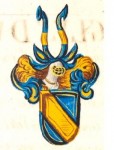
The coat of arms of the Thun-Hohenstein family consists of a gold slanting beam against an azure background. The helmet shows two blue buffalo horns, each with a blue, diagonal beam. The crest is in azure and gold.
Unification of different coats of arms
After the line of the Counts of Eschenlohe [1] died out at the start of the 14th century, the Counts of Tyrol initially received their coat of arms [2] 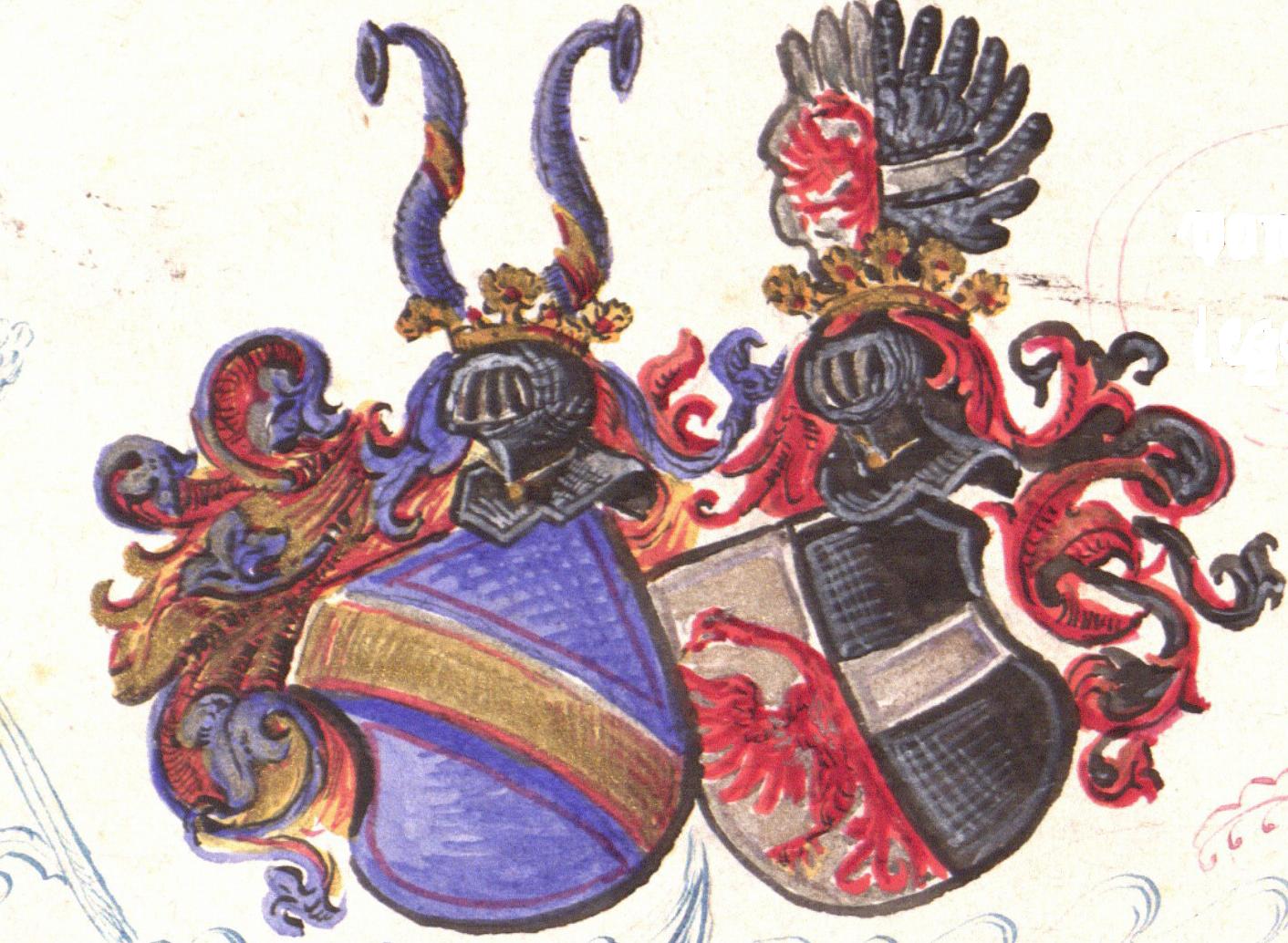 and their holdings. Since Königsberg Castle was granted by Duke Friedrich IV to Simon von
and their holdings. Since Königsberg Castle was granted by Duke Friedrich IV to Simon von 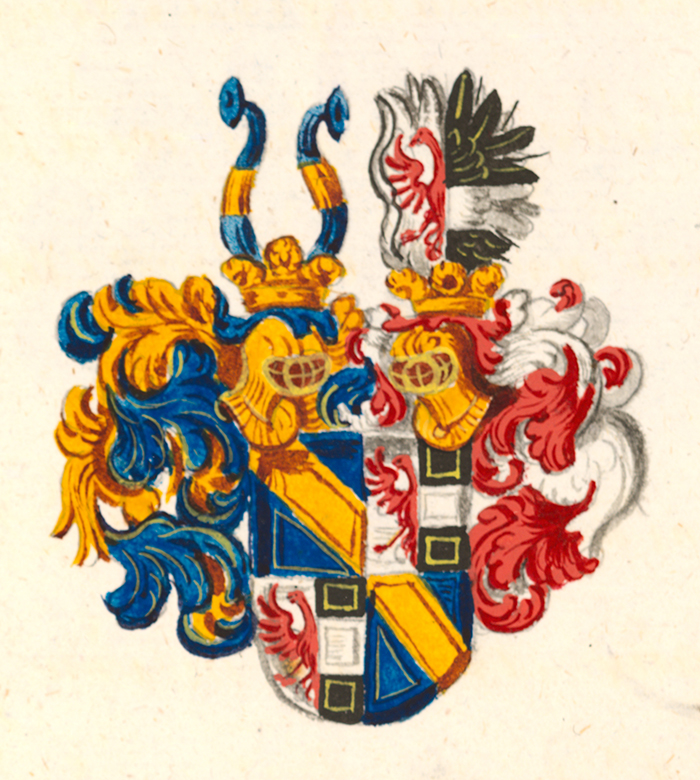 Thun
Thun ![]() and his son, Balthasar
and his son, Balthasar ![]() , at the start of the fifteenth century, it has been in the possession of the Thuns. On 22 May 1516 [3], Bernhard von Thun
, at the start of the fifteenth century, it has been in the possession of the Thuns. On 22 May 1516 [3], Bernhard von Thun ![]() received permission from Emperor Maximilian I to incorporate the coat of arms of Königsberg into the Thuns' own coat of arms, thus recording the increase in their holdings in the Thun family's coat of arms. [4] This coat of arms remained in use until the family's elevation to the status of Counts in 1629 and is as divided into quarters, as follows: Fields 1 and four show a gold, diagonal bar against an azure background in reference to the family's original coat of arms. Fields 2 and 3 are divided, and at the front contain a displayed and expanded red (gules) eagle edged in black with a silver crossbar against a black (sable) background in reference to Königsberg. Above the coat of arms is a crowned helmet with two blue buffalo horns with golden oblique bars. The crest is in azure and gold. On the left hand side, there is a crowned helmet, with a red eagle displayed and expanded red (gules) eagle and a silver crossbar against a black (sable) background. The crest is in red and silver or black and silver.
received permission from Emperor Maximilian I to incorporate the coat of arms of Königsberg into the Thuns' own coat of arms, thus recording the increase in their holdings in the Thun family's coat of arms. [4] This coat of arms remained in use until the family's elevation to the status of Counts in 1629 and is as divided into quarters, as follows: Fields 1 and four show a gold, diagonal bar against an azure background in reference to the family's original coat of arms. Fields 2 and 3 are divided, and at the front contain a displayed and expanded red (gules) eagle edged in black with a silver crossbar against a black (sable) background in reference to Königsberg. Above the coat of arms is a crowned helmet with two blue buffalo horns with golden oblique bars. The crest is in azure and gold. On the left hand side, there is a crowned helmet, with a red eagle displayed and expanded red (gules) eagle and a silver crossbar against a black (sable) background. The crest is in red and silver or black and silver.
Unification with the Caldes and the current Thun-Hohenstein Coat of Arms
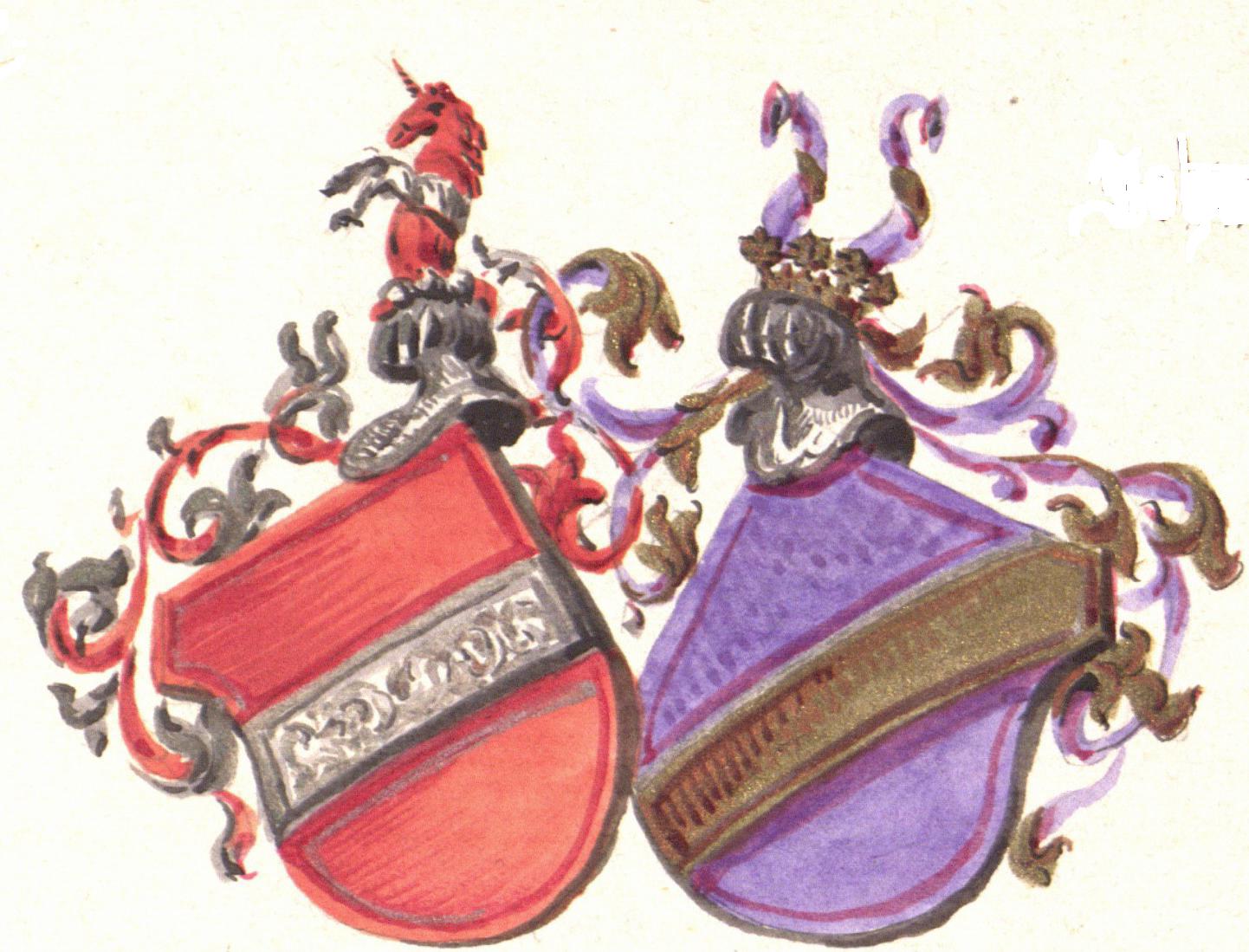 As early as 14 July 1464, the entire estate of Pretel von Caldes came into the possession of the Thuns by way of gift decree. [5] Pretel von Caldes, who was himself without issue, transferred
As early as 14 July 1464, the entire estate of Pretel von Caldes came into the possession of the Thuns by way of gift decree. [5] Pretel von Caldes, who was himself without issue, transferred 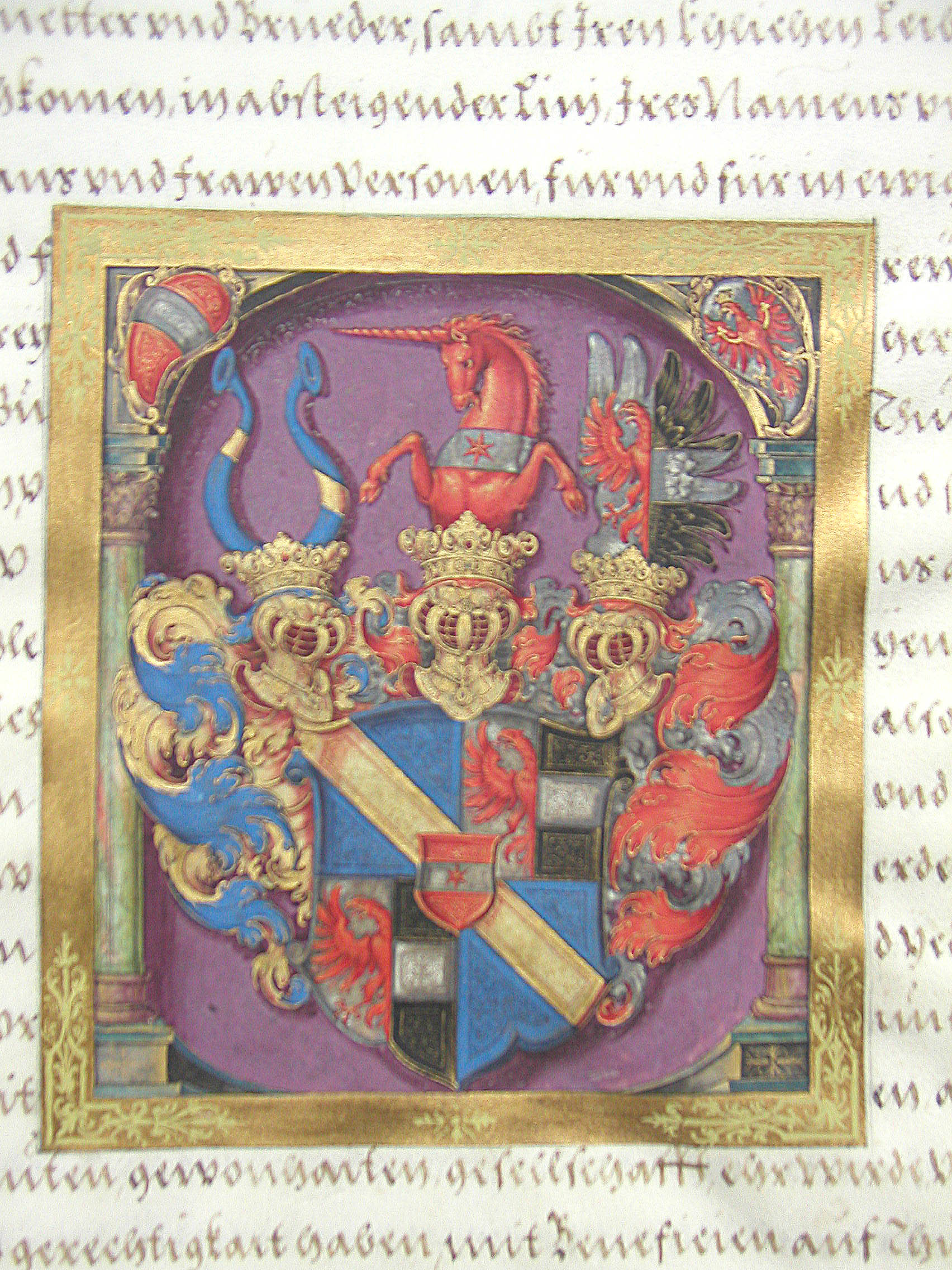 all his possessions to Sigmund's
all his possessions to Sigmund's ![]() sons, Simon
sons, Simon ![]() , Jakob
, Jakob ![]() and Balthasar
and Balthasar ![]() . [6] In December 1603, the patriarchs of the various branches of the family [break] laid claim to a barony and simultaneously sought the incorporation of the Caldes coat of arms into the family's own [7], which was settled on 9 March 1604 by Archduke Maximilian when they were elevated to the rank of baron. approved. [8] As, however, the Caldes coat of arms was the same as that of the Austria, it was agreed that a red star would be added to the white transom. The Thun-Hohenstein family declined to add the star, and in the list of nobles that appeared in 1629, the star had in fact disappeared. [9]
. [6] In December 1603, the patriarchs of the various branches of the family [break] laid claim to a barony and simultaneously sought the incorporation of the Caldes coat of arms into the family's own [7], which was settled on 9 March 1604 by Archduke Maximilian when they were elevated to the rank of baron. approved. [8] As, however, the Caldes coat of arms was the same as that of the Austria, it was agreed that a red star would be added to the white transom. The Thun-Hohenstein family declined to add the star, and in the list of nobles that appeared in 1629, the star had in fact disappeared. [9] 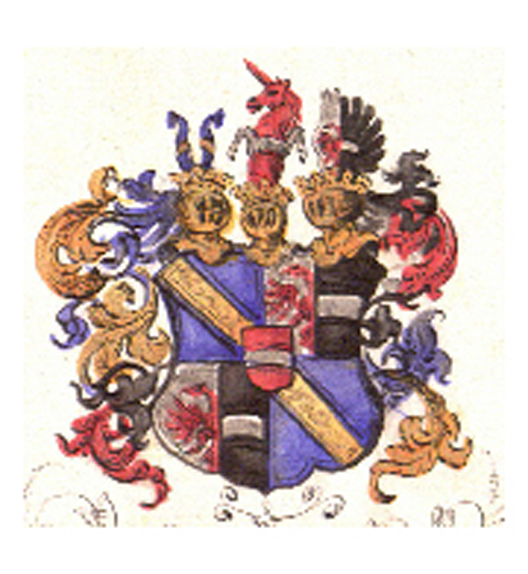 The contemporary coat of arms of the Thun-Hohenstein family is divided into quarters and contains an additional, silver escutcheon with a red (gules) transom. Fields 1 and four show a gold, diagonal bar against an azure background. Fields 2 and 3 are divided, and at the front contain a displayed and expanded red (gules) eagle edged in black with a silver transom against a black (sable) background. Three golden crowned helmets are arranged above: with two blue buffalo horns on the right, accompanied by an oblique right-angle and sloping beam; in the centre with a rearing (forcené) unicorn; left and front a displayed and expanded red (gules) eagle against a silver background and a silver transom against a black (sable) background. The crests are a mixture of blue and gold, red and silver, and black and silver. [DL] General information on heraldry
The contemporary coat of arms of the Thun-Hohenstein family is divided into quarters and contains an additional, silver escutcheon with a red (gules) transom. Fields 1 and four show a gold, diagonal bar against an azure background. Fields 2 and 3 are divided, and at the front contain a displayed and expanded red (gules) eagle edged in black with a silver transom against a black (sable) background. Three golden crowned helmets are arranged above: with two blue buffalo horns on the right, accompanied by an oblique right-angle and sloping beam; in the centre with a rearing (forcené) unicorn; left and front a displayed and expanded red (gules) eagle against a silver background and a silver transom against a black (sable) background. The crests are a mixture of blue and gold, red and silver, and black and silver. [DL] General information on heraldry
Bibliography
Ausserer, Carl: Der Adel des Nonsberges (The Nobility of the Nonsberg). With 72 illustrations of castles, coats of arms, and seals. In: Jahrbuch der k.k. heraldischen Geselleschaft (Yearbook of the Royal Heraldic Society); Vol. 9, Vienna 1899. pp.13-241. Gluckselig, Legis: Denkwürdigkeiten des Grafenhauses Thun-Hohenstein (Memorabilia of the House of Thun-Hohenstein) Festgabe zu dem achtzigsten Geburtstag seiner Excellenz des hochgeborenen Herrn Franz Grafen von Thun-Hohenstein, Prague 1866. (On the occasion of the 80th birthday of His Excellency, Franz Count of Thun-Hohenstein) Haidacher, Christoph: Die Grafen von Eschenlohe-Hertenberg (The Counts of Eschenlohe-Hertenberg). Ein Beispiel für die Adelspolitik Meinrads II., gesehen unter dem Blickwinkel der Landeswerdung Tirols, in: Tiroler Heimat. (An example of Meinrad II's policy on the nobility from the perspective of Tyrol) in Tiroler Heimat: Jahrbuch für Geschichte und Volkskunde (The Tyrolean Homeland: Yearbook of History and Folklore); Vol.57, Innsbruck 1993, p.7-16.
